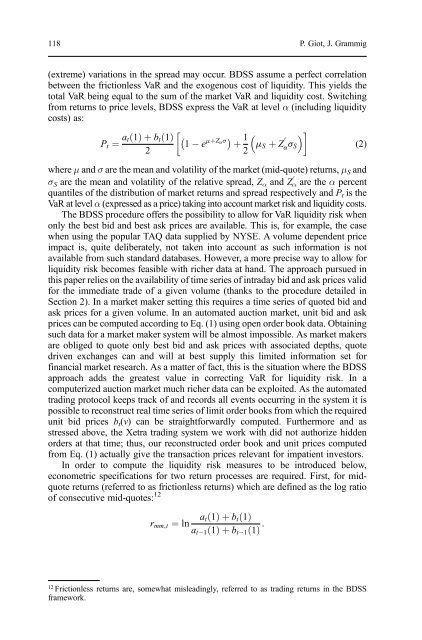recent developments in high frequency financial ... - Index of
recent developments in high frequency financial ... - Index of
recent developments in high frequency financial ... - Index of
You also want an ePaper? Increase the reach of your titles
YUMPU automatically turns print PDFs into web optimized ePapers that Google loves.
118<br />
(extreme) variations <strong>in</strong> the spread may occur. BDSS assume a perfect correlation<br />
between the frictionless VaR and the exogenous cost <strong>of</strong> liquidity. This yields the<br />
total VaR be<strong>in</strong>g equal to the sum <strong>of</strong> the market VaR and liquidity cost. Switch<strong>in</strong>g<br />
from returns to price levels, BDSS express the VaR at level α (<strong>in</strong>clud<strong>in</strong>g liquidity<br />
costs) as:<br />
Pt ¼ atð1Þþbtð1Þ 2<br />
1 e þZ þ 1<br />
2<br />
S þ Z 0<br />
where μ and σ are the mean and volatility <strong>of</strong> the market (mid-quote) returns, μS and<br />
σS are the mean and volatility <strong>of</strong> the relative spread, Zα and Z 0<br />
α are the α percent<br />
quantiles <strong>of</strong> the distribution <strong>of</strong> market returns and spread respectively and Pt is the<br />
VaR at level α (expressed as a price) tak<strong>in</strong>g <strong>in</strong>to account market risk and liquidity costs.<br />
The BDSS procedure <strong>of</strong>fers the possibility to allow for VaR liquidity risk when<br />
only the best bid and best ask prices are available. This is, for example, the case<br />
when us<strong>in</strong>g the popular TAQ data supplied by NYSE. A volume dependent price<br />
impact is, quite deliberately, not taken <strong>in</strong>to account as such <strong>in</strong>formation is not<br />
available from such standard databases. However, a more precise way to allow for<br />
liquidity risk becomes feasible with richer data at hand. The approach pursued <strong>in</strong><br />
this paper relies on the availability <strong>of</strong> time series <strong>of</strong> <strong>in</strong>traday bid and ask prices valid<br />
for the immediate trade <strong>of</strong> a given volume (thanks to the procedure detailed <strong>in</strong><br />
Section 2). In a market maker sett<strong>in</strong>g this requires a time series <strong>of</strong> quoted bid and<br />
ask prices for a given volume. In an automated auction market, unit bid and ask<br />
prices can be computed accord<strong>in</strong>g to Eq. (1) us<strong>in</strong>g open order book data. Obta<strong>in</strong><strong>in</strong>g<br />
such data for a market maker system will be almost impossible. As market makers<br />
are obliged to quote only best bid and ask prices with associated depths, quote<br />
driven exchanges can and will at best supply this limited <strong>in</strong>formation set for<br />
f<strong>in</strong>ancial market research. As a matter <strong>of</strong> fact, this is the situation where the BDSS<br />
approach adds the greatest value <strong>in</strong> correct<strong>in</strong>g VaR for liquidity risk. In a<br />
computerized auction market much richer data can be exploited. As the automated<br />
trad<strong>in</strong>g protocol keeps track <strong>of</strong> and records all events occurr<strong>in</strong>g <strong>in</strong> the system it is<br />
possible to reconstruct real time series <strong>of</strong> limit order books from which the required<br />
unit bid prices bt(v) can be straightforwardly computed. Furthermore and as<br />
stressed above, the Xetra trad<strong>in</strong>g system we work with did not authorize hidden<br />
orders at that time; thus, our reconstructed order book and unit prices computed<br />
from Eq. (1) actually give the transaction prices relevant for impatient <strong>in</strong>vestors.<br />
In order to compute the liquidity risk measures to be <strong>in</strong>troduced below,<br />
econometric specifications for two return processes are required. First, for midquote<br />
returns (referred to as frictionless returns) which are def<strong>in</strong>ed as the log ratio<br />
<strong>of</strong> consecutive mid-quotes: 12<br />
rmm;t ¼ ln atð1Þþbtð1Þ at 1ð1Þþbt1ðÞ 1<br />
:<br />
12 Frictionless returns are, somewhat mislead<strong>in</strong>gly, referred to as trad<strong>in</strong>g returns <strong>in</strong> the BDSS<br />
framework.<br />
S<br />
P. Giot, J. Grammig<br />
(2)










